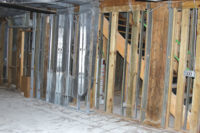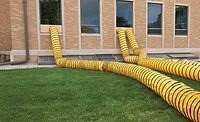Understanding the Transfer of Energy in Restorative Drying




The most important principle of drying is to understand the transfer of energy. No one can argue that drying at the correct temperature is the most effective way to restore a wet structure to its pre-loss condition. Dry too slowly, dry too fast, dry too little, or drying too long are all problematic. Moreover, ANSI/IICRC S500 defines the purpose of drying structural materials in ways that assist restorers by using procedures that are quick, efficient and cost effective.
Humidity, airflow, temperature and time (HATT principle) are four elements commonly referred to as the “Drying Pie.” Drying time is directly related to the temperature differential between water trapped in materials and the surrounding air, making heat, arguably, one of the most practical ways to dry. The exchange of heat and water vapor from a wet surface determines how quickly a surface will dry. This has been shown in numerous studies on various materials.
Oftentimes, visualizing the phenomenon of evaporation is difficult. When we are evaporating moisture we are changing water from a liquid to a gas and as anybody who has studied psychrometry understands, using a chart or a calculator helps to make what is often invisible – visible.
There are times when you can see water vapor evaporating. I watched the phenomenon take place last week in Boston when the air temperatures plummeted to sub freezing over the warmer water and the exchange of heat and water vapor created sea smoke, or fog. The characteristics of fog resulting from the transfer of heat from relatively warm water to the cooler air have been investigated at the prestigious Woods Hole Oceanographic Institute (Sea Smoke and Steam Fog, P.M. Sanders January 1964). Witnessing this phenomenon depends on the scale of heat and time. You can also see water evaporate when heat is added to a pan of water and evaporation accelerates.
The S500 defines qualifications for restorers as individuals qualified by education, training and experience to appropriately execute a key set of “core” skills on water damage restoration projects. Heat energy has a significant effect on drying time and should be one of the concepts technicians understand.
Our industry has evolved through a better understanding of science. The HATT principle incorporates multiple components - important elements that should be understood and applied correctly. Driving a car has similarities. If you want to get somewhere faster – step on the gas – direct more energy to the engine. Of course you should only accelerate so fast and you have brakes and gauges to monitor speed, RPM, temperature and a mirror to monitor for blue lights. Heat drying is like stepping on the gas – drying takes place faster. Like driving, it needs to be monitored.
There are numerous reasons to use heat to help dry. Heat energy is an important tool for restorers. Proper use of heat energy is no different then proper balancing of dehumidification equipment – use too little and secondary damage can result from condensation or longer drying time, use too much and energy is wasted and the cost effective element the S500 dictates is lost. Evaporation must also be considered when refrigerant dehumidification is employed. Evaporate too fast without an equal reduction through dehumidification and an ensuing rise in humidity can result in secondary damage.
Heat drying has many advantages over refrigerant dehumidification for restorers, insurers and consumers alike. Quickly evaporating excess water reduces drying time and helps create conditions unfavorable for microbial growth. Proper heat application, like proper refrigerant dehumidification, in manageable amounts, under the supervision of those qualified by training and experience is key.
Controlling the drying rate is a fundamental rule of drying. Restorers must adhere to drying structural materials in ways that are quick, efficient and cost effective. Heat drying is an essential tool restorers should consider when efficiency matters. It reduces drying time, one of the basic tenets of water damage mitigation.
The full benefits of any drying technology can be gained only when certain prerequisites are observed. Restorers must recognize the importance of heat and must be well trained and encouraged to apply the best drying techniques available. Refrigerant dehumidifiers and directed heat drying technology each have their own advantages when used properly.
The major difference between refrigerant dehumidification using air movers for evaporation versus evaporation from directed heat energy applied directly to the water, is the speed by which moisture is evaporated from the wet material. Today’s modern heat drying units employ state-of-the-art technology to limit energy use, temperature, turn on and off equipment, document drying conditions and some have provisions for periodically venting excess moisture laden heat to the outside while maintaining warm air in the drying chamber. They are both energy and cost efficient when properly operated and should be considered an essential tool in the drying industry.
In general, when compared to other drying methods, directed heat energy provides a much faster drying time minimizing the opportunity for microbial growth when properly used. Restorative drying with heat can be a quick, efficient, cost effective way to dry structural materials for those technicians who have the knowledge and training necessary in today’s fast growing industry.
Looking for a reprint of this article?
From high-res PDFs to custom plaques, order your copy today!









